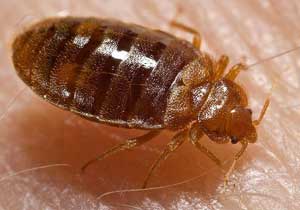
Bed Bugs
Like most of these little suckers, itching is one of the first signs of being infested with bed bugs, although another telltale sign may be blood splats on bed linen. The irritation that causes the itching is an allergic reaction to a chemical in bed bug saliva, but as annoying as these blood-suckers are, they do not spread disease.
Bed bugs (Cimex lectularius) have been making a comeback in recent years, with domestic infestations being reported in increasing numbers. This is partly due to their resistance to insecticides. In fact, researchers are now studying bed bugs’ DNA to find out how to break down their defences.
Bed bugs are most active during the dark. They like to feed between midnight and 5am when a person is usually sleeping. A feed takes about 10 minutes and then they quietly slip back into hiding without disturbing the donor. You can go days or weeks without ever seeing a living bug. Some people will react to the bite by developing bumps or a rash while others display no symptoms at all. The bugs only feed once every 3-4 days.
Head Lice
Of the three kinds of lice that can infest humans – head lice (Pediculus capitis), body lice
(P. humanus) and crab or pubic lice (Phthirus pubis), head lice are the most common.
The body louse is very rare, occurring in unsanitary, crowded conditions where people wear the same clothing for many days. Crabs (or pubic) lice are usually transferred from one individual to another through intimate contact, but occasionally can be transferred in other ways. Head lice are easily spread by physical contact and infestations can occur under the best sanitary conditions.
Head lice are reddish-brown and wingless. Adults do not fly or jump from one person to another. Female head lice lay 50 to 150 eggs. The eggs are called nits. Nits are shiny white and are about half the size of a pinhead. They are glued individually to hair shafts close to the scalp, and hatch after 5 to 10 days into small nymphs. Head-lice nymphs moult (shed their skin) three times, gradually becoming adults in about three weeks. Head lice cannot live away from a host for more than 48 hours.
Head lice infestations typically result in an itching sensation at the back of the scalp. In children, this itching sensation is often most noticeable at night and associated with loss of sleep. The scratching can result in a secondary infection that may be more uncomfortable than the bites themselves.
To prevent infestations, children should never share hats, combs, hairbrushes or similar items. All clothing, bedding and towels used by the infested person should be washed in hot, soapy water to kill the lice.
Scabies
Scabies is a mite infestation of the skin. The scabies mite, also known as the human itch or mange mite, causes intense itching and is contagious. When a person catches scabies, pregnant female mites dig burrows in the skin and lay eggs along the way.
The burrow appears as a fine, wavy and slightly scaly line that’s a few millimetres to one centimetre long. A tiny mite (0.3 to 0.4 mm) may sometimes be seen at the end of the burrow. Most burrows occur in the webs of fingers, flexing surfaces of the wrists, around elbows and armpits, the breasts in females and on genitals of males, along the belt line, and on the lower buttocks.
Scabies are transmitted readily, often throughout an entire household, by prolonged skin-to-skin contact with an infected person (such as bed partners). It takes about four to six weeks to develop symptoms after initial infestation and thus a person can be contagious for at least a month before they are diagnosed.
Scabies are treated by killing the mites and their eggs. Prescription skin creams or lotions containing 5% permethrin, lindane, or crotamiton will kill the mites and eggs. Lotions must be applied according to the package directions. It can take one to two weeks after treatment for the itching to stop.
If you suspect you have scabies, see a dermatologist (skin doctor) or your GP right away. Remember, scabies does not indicate anything about your personal cleanliness.
Comments are closed.